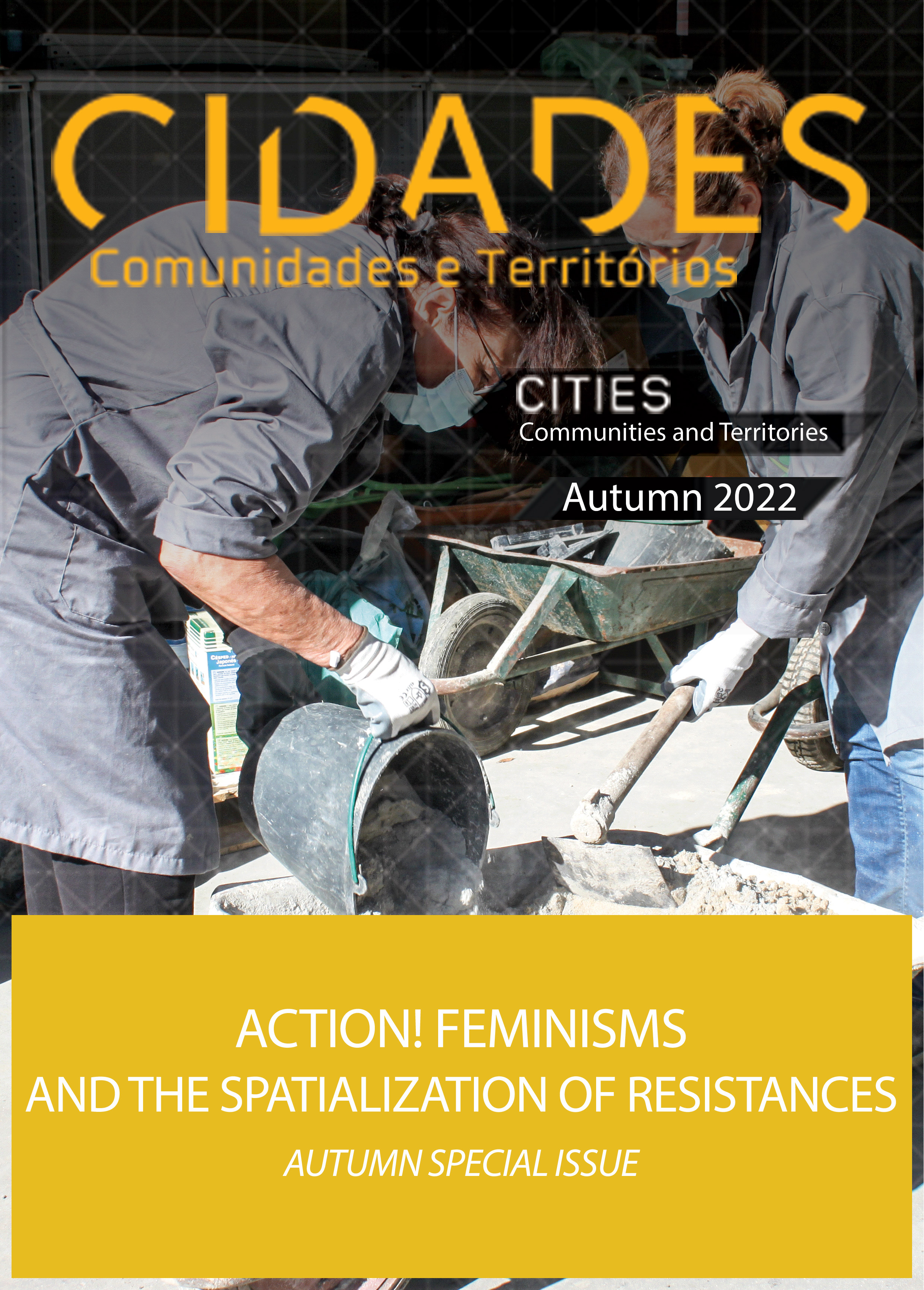fem*MAP Berlin 2049
Feminist spatial systems for a non-sexist city
Keywords:
feminist spatial production, non-sexist city, feminist practices of resistance, feminist planning practice, critical mappingAbstract
In search of a feminist perspective for Berlin and an answer to the question of what a non-sexist city could and should look like, an analysis of hegemonic and feminist spatial systems was carried out based on practice-based teaching research formats. Using critical mapping (Harley, 1989; Wood, 1992) with a collective-feminist approach, this paper will demonstrate the potential of the map as a tool that allows for a non-hegemonic perspective of space. The mapping research reveals how the dichotomy of the terms public and private determines hegemonic spatial systems and how the concept of commons as a counter-image and third spatial realm opens up a possible typology of feminist spatial systems. Thus, in the evaluation of the results, the need for new common notions in urban planning discourse is discussed.
References
Arendt, H. (1960). Vita Aktiva oder Vom tätigen Leben. Stuttgart: W. Kohlhammer Verlag.
Autorinnenkollektiv Geographie und Geschlecht (Hg.) (2021). Handbuch Feministische Geographien. Arbeitsweisen und Konzepte. Opladen, Berlin, Toronto: Verlag Barbara Budrich GmbH.
Awan, N. (2017). Mapping Otherwise. In M. Schalk, T. Kristiansson, & R. Mazé (Eds.), Feminist Futures of Spatial Practice: Materialisms, Activism, Dialogues, Pedagogies (1st ed., pp. 33–41). Baunach: AADR/ Spurbuchverlag.
Becker, R. (2004). Feministische Kritik an Stadt und Raum. Gender Mainstreaming und Managing Diversity. Sozialwissenschaften und Berufspraxis, 27(4), 377–386.
Becker, R. (2008). Raum: Feministische Kritik an Stadt und Raum. In R. Becker & B. Kortendiek (Hg.), Handbuch Frauen- und Geschlechterforschung. Theorie, Methoden, Empirie (2., erw. und aktualisierte Aufl., pp. 798–811). Wiesbaden: VS Verlag für Sozialwissenschaften.
Bundesministerium für Wirtschaft und Energie (2019). Pflege ist ein Wirtschaftsfaktor. https://www.bmwi.de/Redaktion/DE/Artikel/Branchenfokus/Wirtschaft/branchenfokus-pflegewirtschaft.html
Doderer, Y.P. (2002). Less or More? Perspektiven feministischer Planung. dérive Zeitschrift für Stadtforschung, 7 (Jan-Mär 2002), 11–14.
Harley, J. B. (1989). Deconstructing the Map. Cartographica: The international journal for geo-graphic information and geovisualization, 26(2), 1–20.
Federici, S. (2012). Revolution at Point Zero. Housework, Reproduction, and Feminist Struggle, Oakland: PM Press.
Federici, S. (2012). Caliban und die Hexe. Frauen, Körper und die ursprüngliche Akkumulation. Wien: Mandelbaum Verlag.
Hayden, D. (2017 [1981]). Wie könnte eine nicht-sexistische Stadt aussehen? Überlegungen zum Wohnen, zur städtischen Umwelt und zur menschlichen Arbeit. suburban. Zeitschrift für Kritische Stadtforschung, 5(3), 69–86.
Institut Arbeit und Qualifikation (2021). Krankenhäuser und Betten nach Trägerschaft 1992-2020. https://www.sozialpolitik-aktuell.de/files/sozialpolitik-aktuell/_Politikfelder/Gesundheitswesen/Datensammlung/PDF-Dateien/abbVI32b.pdf
Kelling E., Pelger, D., Löw, M., & Stollmann, J. (Eds.) (2020). Wohnhaft im Verborgenen. Die Hostelwirtschaft mit Wohnungslosen in Berlin. Berlin: Universitätsverlag der TU Berlin. https://doi.org/10.14279/depositonce-9979
Koepper, J., Pelger, D., Wegewitz, M. & Stollmann, J. (Eds.) (2021): fem*MAP BERLIN. Feminist spatial systems for a non-sexist city. http://dx.doi.org/10.14279/depositonce-11708
Löw, M. (2001). Raumsoziologie. Frankfurt am Main: Suhrkamp.
Marguin, S., Pelger, D., & Stollmann, J. (2021). Mappings als Joint Spatial Display. In A. J. Hein-rich, S. Marguin, A. Million, & J. Stollmann (Eds.), Handbuch qualitative und visuelle Methoden der Raumforschung (pp. 381–399). Bielefeld: transcript.
Reuschling, F. (2013). Domestic Utopias. Eine feministische Erkundung des gebauten Raums. In NGBK Berlin (Ed.), Domestic Utopias. Katalog zur Ausstellung. Berlin: NGBK Berlin.
Reuschling, F. (2017). Eine feministische Perspektive für Berlin heute. Kommentar zu Dolores Haydens „Wie könnte eine nicht-sexistische Stadt aussehen?” (1981). suburban. Zeitschrift für Kritische Stadtforschung, 5(3), 115–124. https://doi.org/10.36900/suburban.v5i3.319
Samtleben, C., Lott, Y., & Müller, K. U. (2020). Auswirkungen der Ort-Zeit-Flexibilisierung von Erwerbsarbeit auf informelle Sorgearbeit im Zuge der Digitalisierung, Expertise für den Dritten Gleichstellungsbericht der Bundesregierung, DIW Berlin.
Statistisches Bundesamt (2019). Verdienstunterschied zwischen Frauen und Männern 2018 un-verändert bei 21 Prozent. https://www.destatis.de/DE/Presse/Pressemitteilungen/2019/03/PD19_098_621.html;jsessionid=EB052B501272468CC48EB2175A3A3A51.InternetLive1%3E
UN Women (2019). UN Women's Progress of the World's Women 2019-2020. Families in a changing world. New York: United Nations Entity for Gender Equality and the Empowerment of Women.
Wischermann, U. (2003). Feministische Theorien zur Trennung von privat und öffentlich – Ein Blick zurück nach vorn. Feministische Studien, 21(1), 23–34.
Wood, D. (1992). The Power of Maps. New York: Guilford Press.
Downloads
Published
Issue
Section
License
Copyright (c) 2022 Julia Koepper, Martha Wegewitz, Dagmar Pelger

This work is licensed under a Creative Commons Attribution-NonCommercial-NoDerivatives 4.0 International License.
Cidades, Comunidades e Territórios by DINÂMIA'CET-IUL is licensed under a Creative Commons Atribuição-Uso Não-Comercial-Proibição de realização de Obras Derivadas 4.0 Unported License.Permissions beyond the scope of this license may be available at mailto:cidades.dinamiacet@iscte.pt.






